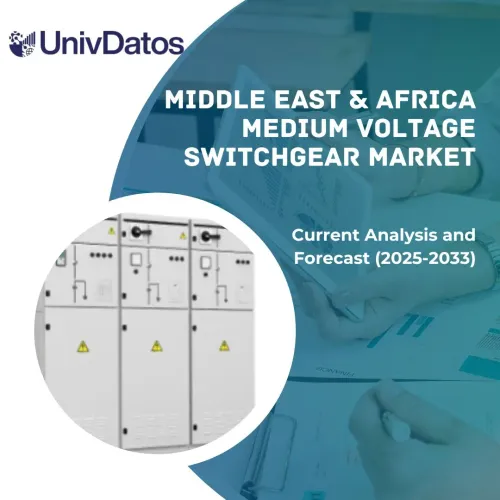- Strona główna
- O nas
- Branża
- Usługi
- Czytanie
- Kontakt
Rynek wierceń podmorskich: Analiza bieżąca i prognoza (2023-2030)
Nacisk na typ platformy (platforma samopodnośna, statek wiertniczy i platforma półzanurzalna); głębokość wody (wody płytkie oraz wody głębokie i ultragłębokie); oraz region/kraj
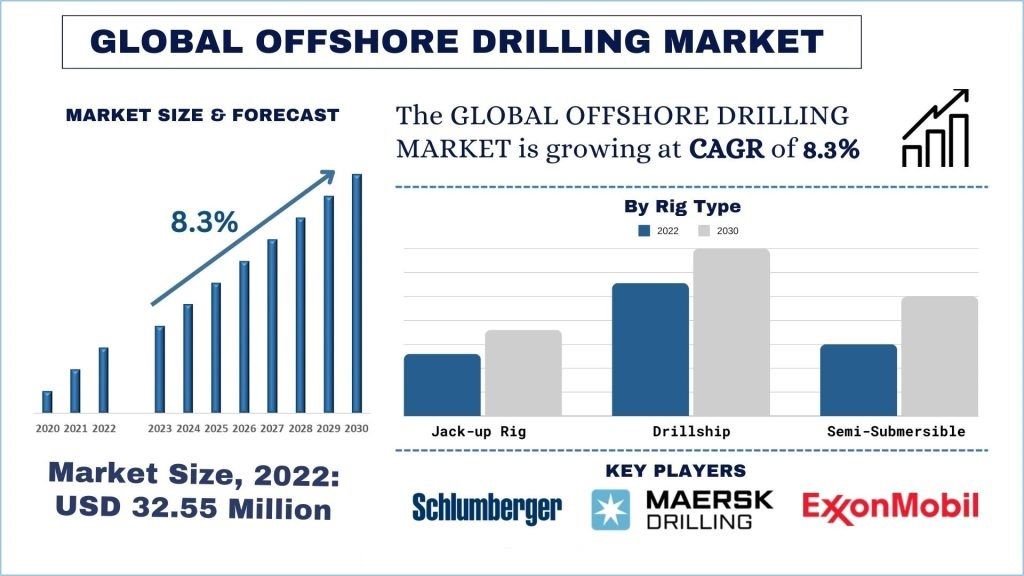
Oczekuje się, że globalny rynek wierceń podmorskich będzie rósł w znaczącym tempie około 8,3% w okresie prognozy. Czynniki takie jak rosnący globalny popyt na energię, wyczerpywanie się rezerw na lądzie i wodach płytkich, innowacyjne technologie, takie jak zaawansowane platformy wiertnicze, podmorskie systemy produkcyjne i ulepszone techniki wydobycia ropy, wysokie ceny ropy i gazu, dywersyfikacja gospodarcza, wspierająca polityka rządowa i przejście na energię odnawialną to niektóre z czynników napędzających globalny rynek wierceń podmorskich.
Amerykańska Agencja Informacji Energetycznej (EIA) podaje, że w lipcu 2022 roku na świecie zużyto 98,8 miliona baryłek ropy i paliw płynnych dziennie, co stanowi wzrost o 0,9 miliona baryłek dziennie w porównaniu z lipcem 2021 roku. Dodatkowo, średnia dzienna produkcja ropy i paliw płynnych na całym świecie w 2022 roku ma wynieść około 99,4 miliona baryłek, co stanowi wzrost o 2,1 miliona w porównaniu z 2021 rokiem.
Baker Hughes Company, Halliburton Energy Services Inc, Schlumberger Limited, China Oilfield Services Limited, Nabors Industries Ltd, National Oilwell Varco, Tenaris S.A., Maersk Drilling AS, Exxon Mobil Corporation i China National Offshore Oil Corporation to jedni z kluczowych graczy na rynku. Gracze ci podjęli szereg fuzji i przejęć wraz z partnerstwami, aby ułatwić klientom korzystanie z zaawansowanych technologicznie i innowacyjnych produktów/technologii.
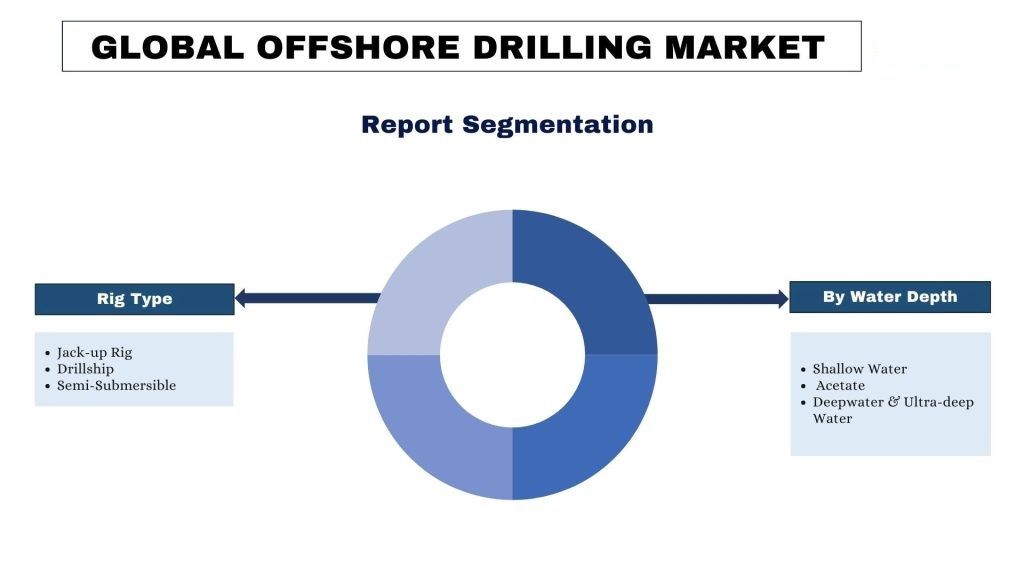
Wnioski przedstawione w raporcie
„Wśród typów platform wiertniczych kategoria statków wiertniczych odnotuje wyższy CAGR w okresie prognozy.”
Na podstawie typu platformy wiertniczej rynek dzieli się na platformy Jack-up Rig, Drillship i Semi-Submersible. Segment Jack-up Rig zdominował rynek w 2022 roku i oczekuje się, że w okresie prognozy będzie się rozwijał w ten sam sposób. Równolegle, statek wiertniczy jest uważany za najszybciej rozwijający się segment ze względu na trwające badania i rozwój w tej dziedzinie oraz rosnącą eksplorację głębokich wód. Ponadto, ponieważ wiercenie na głębokich wodach stwarza ryzyko dla stabilności strukturalnej, platformy Jack-up są często używane do płytkich odwiertów. Jednak wraz z postępem technologii wiercenia, zwiększyły się również ich możliwości, umożliwiając wiercenie na głębokich wodach. Statki wiertnicze to specjalistyczne jednostki przeznaczone do wierceń podmorskich na wodach głębokich i ultra-głębokich. Ich adaptacja rośnie ze względu na wyczerpywanie się rezerw na wodach płytkich i rosnący popyt na zasoby energii w odległych lokalizacjach podmorskich. Postęp technologiczny, taki jak zaawansowany sprzęt wiertniczy i dynamiczne systemy pozycjonowania, poprawił wydajność i bezpieczeństwo statków wiertniczych podczas operacji na głębokich wodach. Odkrycie znacznych złóż ropy i gazu na głębokich wodach, szczególnie w regionach takich jak Zatoka Meksykańska, wybrzeże Brazylii i Afryka Zachodnia, napędzało inwestycje w statki wiertnicze.
Na przykład, w styczniu 2024 r. wykonawca wierceń podmorskich Seadrill ogłosił nowe zamówienie i przedłużenie umowy o łącznej wartości około 97,5 miliona dolarów dla dwóch statków wiertniczych wraz z harmonogramem wznowienia usług zarządzania dla innego statku wiertniczego, który dołączył do jego floty po przejęciu Aquadrill. Ponadto firma zapewniła sobie nowy kontrakt na statek wiertniczy West Vela z Talos Production w Zatoce Meksykańskiej w USA. Szacowany na 150 dni czas trwania tej umowy ma się rozpocząć w trzecim kwartale 2024 roku i stanowi całkowitą wartość kontraktu w wysokości około 73,5 miliona dolarów.
„Wśród głębokości wody segment wód płytkich będzie miał znaczący udział w rynku w 2022 roku.”
Na podstawie głębokości wody rynek dzieli się na wody płytkie oraz wody głębokie i ultra-głębokie. Segment wód płytkich posiada znaczący udział w rynku w 2022 roku i oczekuje się, że będzie wykazywał tę samą tendencję w okresie prognozy. Mniej niż 400-500 metrów wody znajduje się na wodach płytkich. Ze względu na stosunkowo niższe koszty i mniej skomplikowane wymagania techniczne dla operatorów, segment ten posiada największy udział w rynku. Istnieje kilka istotnych różnic między wierceniem na wodach płytkich a wierceniem na wodach głębokich. Oczekuje się, że segment wód głębokich i ultra-głębokich odnotuje najwyższy wzrost ze względu na zmniejszające się rezerwy ropy na wodach płytkich.
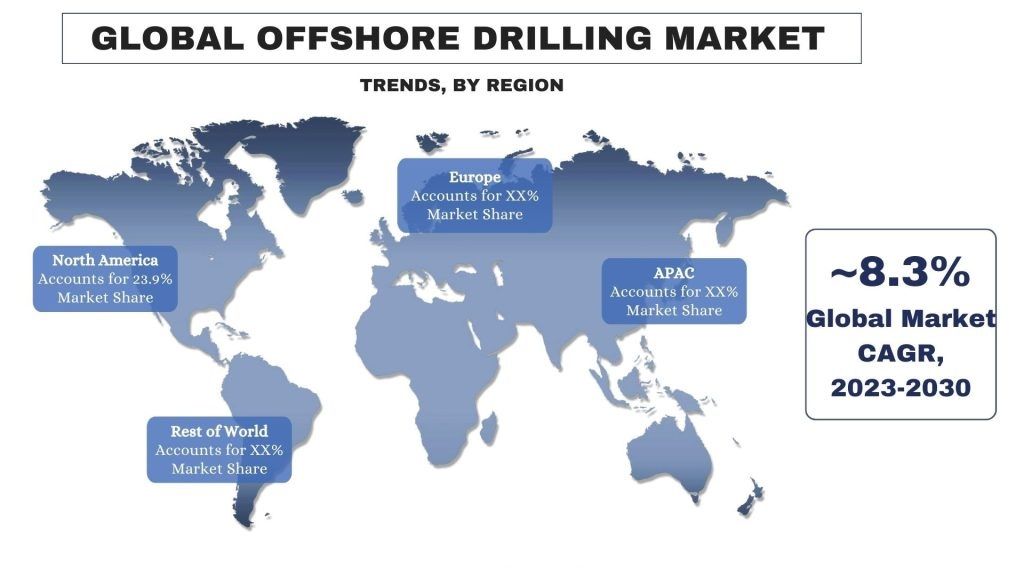
„Ameryka Północna utrzyma znaczny udział w rynku.”
Ameryka Północna odnotowała znaczny wzrost w ostatnich latach ze względu na rosnące inwestycje rządu i prywatnych firm w regionie. Ponadto złoża ropy naftowej i platformy wiertnicze znajdują się zarówno w USA, jak i w Kanadzie. Piaski roponośne w Albercie w Kanadzie produkują 166,3 miliarda baryłek ropy naftowej i dodatkowe 4,7 miliarda baryłek poprzez konwencjonalne i zwarte formacje roponośne. Ponadto piaski roponośne w Kanadzie pozostają głównym źródłem produkcji węglowodorów, stanowiąc ponad 97% całkowitych rezerw ropy naftowej w kraju. Oczekuje się również, że region Zatoki Meksykańskiej będzie produkował dużą ilość ropy naftowej i gazu na morzu w nadchodzących latach, co dodatkowo napędza wiercenia ropy naftowej i gazu na morzu w regionie. Rosnące inwestycje w działalność poszukiwawczą w regionie dodatkowo przyczynią się do rozwoju rynku w okresie prognozy.
W grudniu 2023 roku firmy naftowe zaoferowały 382 miliony dolarów za prawa do wierceń w Zatoce Meksykańskiej. Według Biura Zarządzania Energią Oceaniczną Departamentu Spraw Wewnętrznych USA, firmy, w tym Chevron, Hess i BP, złożyły oferty na ponad 300 działek obejmujących 7000 kilometrów kwadratowych.
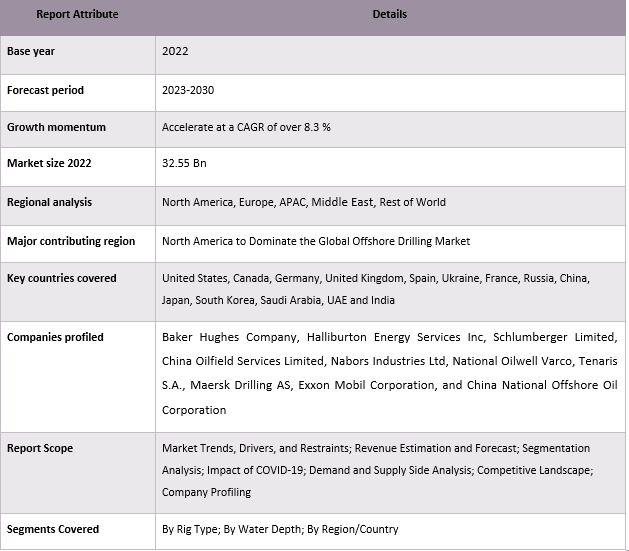
Powody, dla których warto kupić ten raport:
- Badanie obejmuje analizę wielkości rynku i prognozowanie zweryfikowane przez uwierzytelnionych kluczowych ekspertów branżowych.
- Raport przedstawia szybki przegląd ogólnej kondycji branży na pierwszy rzut oka.
- Raport obejmuje dogłębną analizę czołowych firm z branży, z głównym naciskiem na kluczowe dane finansowe, portfolio produktów, strategie ekspansji i najnowsze osiągnięcia.
- Szczegółowe badanie czynników napędzających, ograniczeń, kluczowych trendów i możliwości panujących w branży.
- Badanie kompleksowo obejmuje rynek w różnych segmentach.
- Dogłębna analiza regionalna branży.
Opcje dostosowania:
Globalny rynek wierceń podmorskich można dodatkowo dostosować zgodnie z wymaganiami lub dowolnym innym segmentem rynku. Poza tym UMI rozumie, że możesz mieć własne potrzeby biznesowe, dlatego zachęcamy do kontaktu z nami, aby uzyskać raport, który w pełni odpowiada Twoim wymaganiom.
Spis treści
Metodologia badań rynku wierceń podmorskich (2023-2030)
Analiza historycznego rynku, szacowanie obecnego rynku i prognozowanie przyszłego rynku globalnego rynku wierceń podmorskich to trzy główne kroki podjęte w celu stworzenia i analizy rosnącej popularności i obecnego scenariusza w głównych regionach na całym świecie. Przeprowadzono wyczerpujące badania wtórne w celu zebrania danych historycznych dotyczących rynku i oszacowania obecnej wielkości rynku. Po drugie, aby zweryfikować te spostrzeżenia, wzięto pod uwagę liczne ustalenia i założenia. Ponadto przeprowadzono również wyczerpujące wywiady pierwotne z ekspertami branżowymi w całym łańcuchu wartości globalnego rynku wierceń podmorskich. Po założeniu i walidacji danych rynkowych poprzez wywiady pierwotne, zastosowaliśmy podejście odgórne/oddolne do prognozowania całkowitej wielkości rynku. Następnie przyjęto metody podziału rynku i triangulacji danych w celu oszacowania i analizy wielkości rynku segmentów i podsegmentów, których dotyczy branża. Szczegółowa metodologia została wyjaśniona poniżej:
Analiza historycznej wielkości rynku
Krok 1: Dogłębne badanie źródeł wtórnych:
Przeprowadzono szczegółowe badanie wtórne w celu uzyskania danych historycznych dotyczących wielkości rynku wierceń podmorskich za pośrednictwem wewnętrznych źródeł firmy, takich jak raporty roczne i sprawozdania finansowe, prezentacje wyników, komunikaty prasowe itp. oraz źródeł zewnętrznych, w tym czasopisma, wiadomości i artykuły, publikacje rządowe, publikacje konkurencji, raporty sektorowe, bazy danych stron trzecich i inne wiarygodne publikacje.
Krok 2: Segmentacja rynku:
Po uzyskaniu danych historycznych dotyczących wielkości rynku wierceń podmorskich, przeprowadziliśmy szczegółową analizę wtórną w celu zebrania historycznych informacji o rynku i udziału dla różnych segmentów i podsegmentów w głównych regionach. Główne segmenty zawarte w raporcie to typ platformy i głębokość wody. Przeprowadzono dalsze analizy na poziomie krajowym, aby ocenić ogólne przyjęcie modeli testowych w danym regionie.
Krok 3: Analiza czynnikowa:
Po uzyskaniu danych historycznych dotyczących wielkości rynku różnych segmentów i podsegmentów przeprowadziliśmy szczegółową analizę czynnikową w celu oszacowania obecnej wielkości rynku wierceń podmorskich. Ponadto przeprowadziliśmy analizę czynnikową z wykorzystaniem zmiennych zależnych i niezależnych, takich jak typ platformy i głębokość wody wierceń podmorskich. Przeprowadzono dokładną analizę scenariuszy popytu i podaży, biorąc pod uwagę najważniejsze partnerstwa, fuzje i przejęcia, rozwój działalności i wprowadzenie produktów na rynek w sektorze wierceń podmorskich na całym świecie.
Szacunek i prognoza obecnej wielkości rynku
Określenie obecnej wielkości rynku: Opierając się na przydatnych spostrzeżeniach z powyższych 3 kroków, doszliśmy do obecnej wielkości rynku, kluczowych graczy na globalnym rynku wierceń podmorskich i udziałów w rynku poszczególnych segmentów. Wszystkie wymagane udziały procentowe i podziały rynku określono za pomocą wspomnianego powyżej podejścia wtórnego i zweryfikowano poprzez wywiady pierwotne.
Szacowanie i prognozowanie: Do oszacowania i prognozowania rynku przypisano wagi różnym czynnikom, w tym czynnikom napędzającym i trendom, ograniczeniom i możliwościom dostępnym dla interesariuszy. Po przeanalizowaniu tych czynników zastosowano odpowiednie techniki prognozowania, tj. podejście odgórne/oddolne, aby dojść do prognozy rynkowej na rok 2028 dla różnych segmentów i podsegmentów na głównych rynkach na całym świecie. Metodologia badań przyjęta do oszacowania wielkości rynku obejmuje:
- Wielkość rynku branży pod względem przychodów (USD) i stopa przyjęcia rynku wierceń podmorskich na głównych rynkach krajowych
- Wszystkie udziały procentowe, podziały i rozbicia segmentów rynku i podsegmentów
- Kluczowi gracze na globalnym rynku wierceń podmorskich pod względem oferowanych produktów. Ponadto strategie rozwoju przyjęte przez tych graczy, aby konkurować na szybko rozwijającym się rynku.
Walidacja wielkości i udziału w rynku
Badania pierwotne: Przeprowadzono dogłębne wywiady z kluczowymi liderami opinii (Key Opinion Leaders, KOL), w tym z kadrą kierowniczą najwyższego szczebla (CXO/VP, szefowie sprzedaży, szefowie marketingu, szefowie operacyjni, szefowie regionalni, szefowie krajowi itp.) w głównych regionach. Następnie podsumowano wyniki badań pierwotnych i przeprowadzono analizę statystyczną w celu udowodnienia postawionej hipotezy. Dane wejściowe z badań pierwotnych zostały skonsolidowane z wynikami badań wtórnych, przekształcając w ten sposób informacje w przydatne spostrzeżenia.
Podział uczestników pierwotnych w różnych regionach
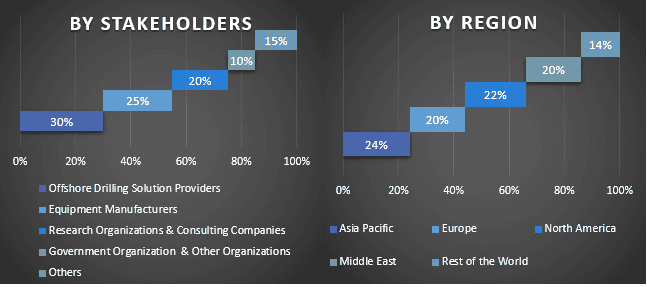
Inżynieria rynku
Zastosowano technikę triangulacji danych w celu ukończenia ogólnego oszacowania rynku i uzyskania precyzyjnych danych statystycznych dla każdego segmentu i podsegmentu globalnego rynku wierceń podmorskich. Dane zostały podzielone na kilka segmentów i podsegmentów po przestudiowaniu różnych parametrów i trendów w obszarach typu i procesu na globalnym rynku wierceń podmorskich.
Główny cel badania globalnego rynku wierceń podmorskich
W badaniu wskazano obecne i przyszłe trendy rynkowe globalnego rynku wierceń podmorskich. Inwestorzy mogą uzyskać strategiczne informacje, na których mogą opierać swoje decyzje dotyczące inwestycji na podstawie analizy jakościowej i ilościowej przeprowadzonej w badaniu. Obecne i przyszłe trendy rynkowe określiły ogólną atrakcyjność rynku na poziomie regionalnym, zapewniając uczestnikom przemysłu platformę do wykorzystania niewykorzystanego rynku, aby czerpać korzyści z przewagi pioniera. Inne ilościowe cele badań obejmują:
- Analiza obecnej i prognozowanej wielkości rynku wierceń podmorskich pod względem wartości (USD). Ponadto analiza obecnej i prognozowanej wielkości rynku różnych segmentów i podsegmentów.
- Segmenty w badaniu obejmują obszary typu i użytkownika końcowego.
- Definicja i analiza ram regulacyjnych dla branży wierceń podmorskich.
- Analiza łańcucha wartości związanego z obecnością różnych pośredników, wraz z analizą zachowań klientów i konkurentów w branży.
- Analiza obecnej i prognozowanej wielkości rynku wierceń podmorskich dla głównego regionu.
- Główne kraje regionów badane w raporcie obejmują Azję i Pacyfik, Europę, Amerykę Północną, Bliski Wschód i resztę świata.
- Profile firm na rynku wierceń podmorskich oraz strategie rozwoju przyjęte przez uczestników rynku, aby utrzymać się na szybko rozwijającym się rynku.
- Dogłębna analiza branży na poziomie regionalnym
Najczęściej zadawane pytania FAQ
P1: Jaka jest obecna wielkość rynku i potencjał wzrostu globalnego rynku wierceń morskich?
P2: Jakie czynniki napędzają wzrost globalnego rynku wierceń offshore?
Pytanie 3: Który segment ma największy udział w globalnym rynku wierceń offshore według typu platformy wiertniczej?
P4: Jakie są wschodzące technologie i trendy na globalnym rynku wierceń offshore?
P5: Który region zdominuje globalny rynek wierceń podmorskich?
P6: Kim są kluczowi gracze działający na globalnym rynku wierceń morskich?
Powiązane Raporty
Klienci, którzy kupili ten przedmiot, kupili również






